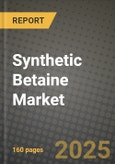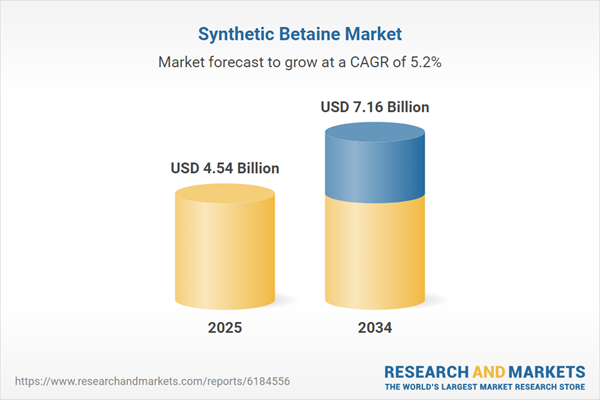Synthetic Betaine Market
Synthetic betaine refers to trimethylglycine and betaine-based surfactants produced via chemical routes rather than extracted from sugar beet vinasse. The portfolio spans anhydrous betaine for nutrition and osmoprotection, betaine hydrochloride for pH control and feed premixes, and amphoteric betaines such as cocamidopropyl betaine for home and personal care cleansing systems. Demand is anchored in personal care shampoos, body washes, and hand soaps where betaines act as secondary surfactants to boost foam, reduce irritation, and improve viscosity build with anionic bases. Adjacent outlets include hard-surface cleaners, dish liquids, agricultural adjuvants, feed and aquaculture osmoregulation, and human nutrition where osmolyte function supports hydration and processing tolerance. Trends emphasize low-salt, low-nitrosamine processes; mildness-forward formulations; sulfate-free systems; and concentrated formats that cut freight and packaging. Sustainability narratives pivot from natural content to life-cycle performance, with interest in mass-balance and bio-based carbon routes while retaining synthetic consistency and purity. Supply dynamics track fatty amine and chloroacetic intermediates, with quality anchored in low residuals, color, and amidoamine content to meet stringent skin-tolerance claims. Competitive differentiation rests on narrow specification windows, micro/nitrosamine control, cold-temperature stability, and technical service that tunes salt curves and rheology across water qualities and fragrances. Emerging themes include betaine blends for high-electrolyte or hard-water stability, ultra-concentrates for e-commerce and refill systems, multifunctional osmolyte use in skin and scalp care, and performance in low-rinse or water-scarce applications. In feeds, heat-stable grades and dust-controlled prills improve premix handling, while aquaculture values osmotic balance under stress conditions.Synthetic Betaine Market Key Insights
- Mildness and foam synergy. As secondary surfactants, betaines reduce irritation while elevating foam volume and stability in sulfate and sulfate-free systems; optimized anionic to betaine ratios deliver creamy lather and better soil suspension.
- Process purity is brand equity. Low nitrosamine, low residual amidoamine, and color control are gating for premium personal care; suppliers with validated analytics and batch consistency win global rollouts.
- Rheology control under constraints. Betaine salt curves interact with electrolytes, fragrances, and actives; know-how in viscosity build at low solids and in cold process manufacturing reduces reformulation time.
- Sulfate-free and concentrated formats. Growth in gentle, low-wash routines favors betaine-rich bases; ultra-concentrates and solid bars rely on amphoteric compatibility to maintain foam with less water.
- Hard-water robustness. Amphoteric character supports performance across water chemistries; tailored grades and co-surfactant maps preserve feel and clarity amid mineral variability.
- Beyond cleansing. Anhydrous betaine functions as an osmolyte and humectant in skin and hair care, improving feel and mitigating surfactant harshness; clear label positioning supports premium claims.
- Home care durability. In dish and hard-surface cleaners, betaine blends improve wetting and grease cut while stabilizing viscosity in high-builder, high-electrolyte formulas and across temperature swings.
- Feed and aquaculture utility. Heat-stable, low-dust betaine supports osmoregulation and intake under stress; consistent assay and flow aid premix uniformity and pelleting performance.
- Sustainability pathways. Mass-balance verification, reduced salt by-products, and energy-efficient routes strengthen ESG scores; concentrated SKUs and refill systems cut transport emissions.
- Supply resilience and compliance. Dual-sourcing of fatty amines and MCA, robust impurity control, allergen and preservative disclosure, and global regulatory dossiers accelerate approvals and audits.
Synthetic Betaine Market Reginal Analysis
North America
Personal care and home care drive steady volume in sulfate-free and sensitive skin lines. Buyers prioritize low-nitrosamine specs, stable viscosity across hard water, and concentrated bases for refill programs. Feed integrators value heat-stable, dust-controlled prills and reliable logistics.Europe
Stronger eco-design and labeling norms favor low-residual, readily biodegradable amphoterics with mass-balance documentation. Premium hair and skin care demand transparent impurity control and cold-process compatibility. Household cleaners move to concentrated and solid formats with amphoteric synergy.Asia-Pacific
Largest growth hub across beauty and home care with fast innovation cycles. Japan and Korea emphasize ultra-mild, clear systems; China and ASEAN scale cost-optimized yet compliant grades. Aquaculture uptake is meaningful in coastal markets, requiring consistent assay and bulk packaging.Middle East & Africa
Hot climates and hard water elevate demand for robust foam and stability; concentrated liquids and solids support e-commerce and small-format retail. Importers seek global dossiers, halal-aligned inputs, and temperature-resilient viscosity.South & Central America
Value-tier shampoos and dish liquids adopt betaines for foam feel at controlled cost; mid-tier brands push sulfate-free claims. Local blenders favor technical support for salt curves, fragrance interaction, and supply reliability amid currency swings.Synthetic Betaine Market Segmentation
By Form
- Betaine Anhydrous
- Cocamidopropyl Betaine
- Betaine Monohydrate
By Application
- Food & Beverages
- Animal Feed
- Cosmetics
- Detergents
Key Market players
Evonik, BASF, Clariant, Solvay, Kao Chemicals, Lubrizol, Innospec, Stepan Company, Nouryon, Dow, Galaxy Surfactants, Zschimmer & Schwarz, Ashland, Huntsman, EnaspolSynthetic Betaine Market Analytics
The report employs rigorous tools, including Porter’s Five Forces, value chain mapping, and scenario-based modelling, to assess supply-demand dynamics. Cross-sector influences from parent, derived, and substitute markets are evaluated to identify risks and opportunities. Trade and pricing analytics provide an up-to-date view of international flows, including leading exporters, importers, and regional price trends.Macroeconomic indicators, policy frameworks such as carbon pricing and energy security strategies, and evolving consumer behaviour are considered in forecasting scenarios. Recent deal flows, partnerships, and technology innovations are incorporated to assess their impact on future market performance.
Synthetic Betaine Market Competitive Intelligence
The competitive landscape is mapped through proprietary frameworks, profiling leading companies with details on business models, product portfolios, financial performance, and strategic initiatives. Key developments such as mergers & acquisitions, technology collaborations, investment inflows, and regional expansions are analyzed for their competitive impact. The report also identifies emerging players and innovative startups contributing to market disruption.Regional insights highlight the most promising investment destinations, regulatory landscapes, and evolving partnerships across energy and industrial corridors.
Countries Covered
- North America - Synthetic Betaine market data and outlook to 2034
- United States
- Canada
- Mexico
- Europe - Synthetic Betaine market data and outlook to 2034
- Germany
- United Kingdom
- France
- Italy
- Spain
- BeNeLux
- Russia
- Sweden
- Asia-Pacific - Synthetic Betaine market data and outlook to 2034
- China
- Japan
- India
- South Korea
- Australia
- Indonesia
- Malaysia
- Vietnam
- Middle East and Africa - Synthetic Betaine market data and outlook to 2034
- Saudi Arabia
- South Africa
- Iran
- UAE
- Egypt
- South and Central America - Synthetic Betaine market data and outlook to 2034
- Brazil
- Argentina
- Chile
- Peru
Research Methodology
This study combines primary inputs from industry experts across the Synthetic Betaine value chain with secondary data from associations, government publications, trade databases, and company disclosures. Proprietary modeling techniques, including data triangulation, statistical correlation, and scenario planning, are applied to deliver reliable market sizing and forecasting.Key Questions Addressed
- What is the current and forecast market size of the Synthetic Betaine industry at global, regional, and country levels?
- Which types, applications, and technologies present the highest growth potential?
- How are supply chains adapting to geopolitical and economic shocks?
- What role do policy frameworks, trade flows, and sustainability targets play in shaping demand?
- Who are the leading players, and how are their strategies evolving in the face of global uncertainty?
- Which regional “hotspots” and customer segments will outpace the market, and what go-to-market and partnership models best support entry and expansion?
- Where are the most investable opportunities - across technology roadmaps, sustainability-linked innovation, and M&A - and what is the best segment to invest over the next 3-5 years?
Your Key Takeaways from the Synthetic Betaine Market Report
- Global Synthetic Betaine market size and growth projections (CAGR), 2024-2034
- Impact of Russia-Ukraine, Israel-Palestine, and Hamas conflicts on Synthetic Betaine trade, costs, and supply chains
- Synthetic Betaine market size, share, and outlook across 5 regions and 27 countries, 2023-2034
- Synthetic Betaine market size, CAGR, and market share of key products, applications, and end-user verticals, 2023-2034
- Short- and long-term Synthetic Betaine market trends, drivers, restraints, and opportunities
- Porter’s Five Forces analysis, technological developments, and Synthetic Betaine supply chain analysis
- Synthetic Betaine trade analysis, Synthetic Betaine market price analysis, and Synthetic Betaine supply/demand dynamics
- Profiles of 5 leading companies - overview, key strategies, financials, and products
- Latest Synthetic Betaine market news and developments
Additional Support
With the purchase of this report, you will receive:- An updated PDF report and an MS Excel data workbook containing all market tables and figures for easy analysis.
- 7-day post-sale analyst support for clarifications and in-scope supplementary data, ensuring the deliverable aligns precisely with your requirements.
- Complimentary report update to incorporate the latest available data and the impact of recent market developments.
This product will be delivered within 1-3 business days.
Table of Contents
Companies Mentioned
- Evonik
- BASF
- Clariant
- Solvay
- Kao Chemicals
- Lubrizol
- Innospec
- Stepan Company
- Nouryon
- Dow
- Galaxy Surfactants
- Zschimmer & Schwarz
- Ashland
- Huntsman
- Enaspol
Table Information
| Report Attribute | Details |
|---|---|
| No. of Pages | 160 |
| Published | November 2025 |
| Forecast Period | 2025 - 2034 |
| Estimated Market Value ( USD | $ 4.54 Billion |
| Forecasted Market Value ( USD | $ 7.16 Billion |
| Compound Annual Growth Rate | 5.2% |
| Regions Covered | Global |
| No. of Companies Mentioned | 15 |









